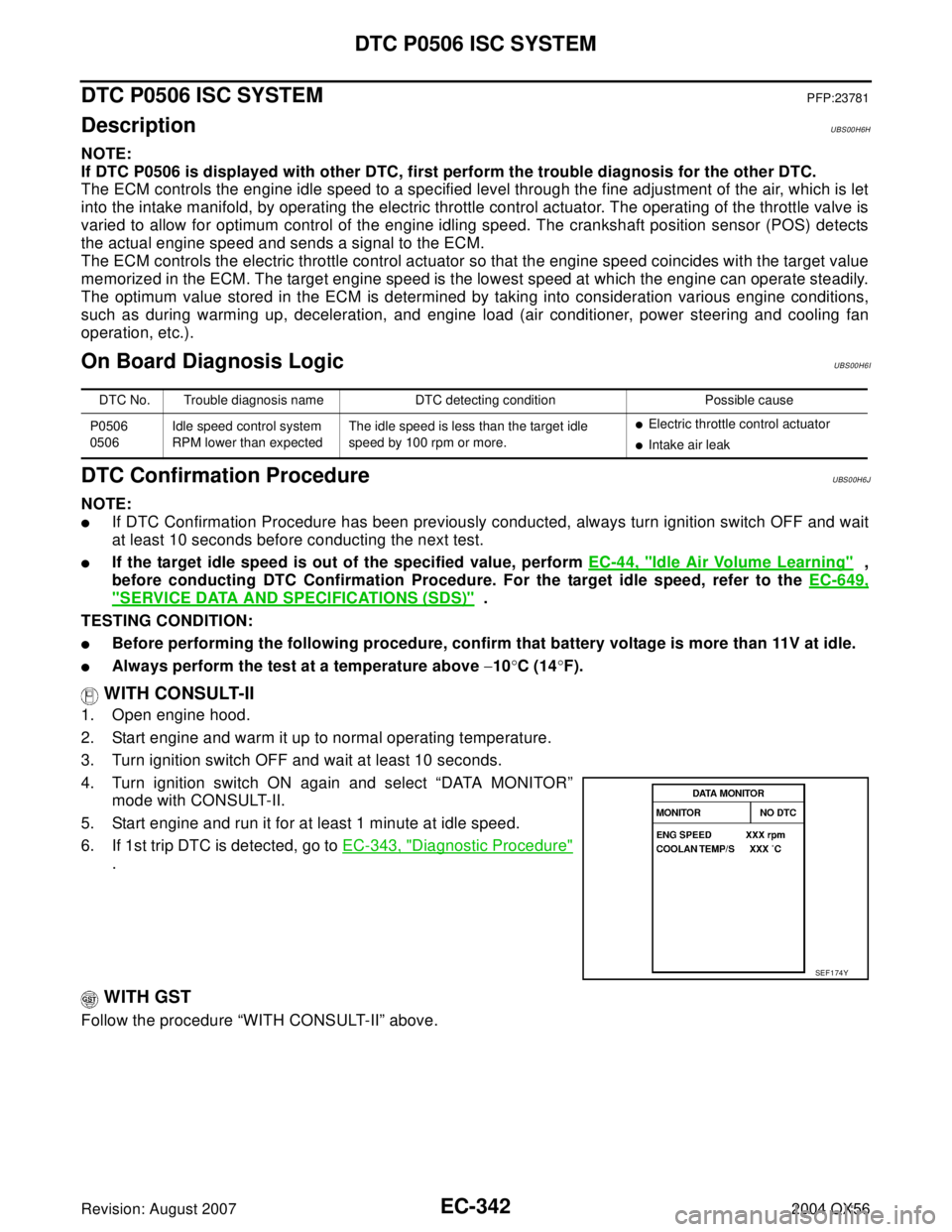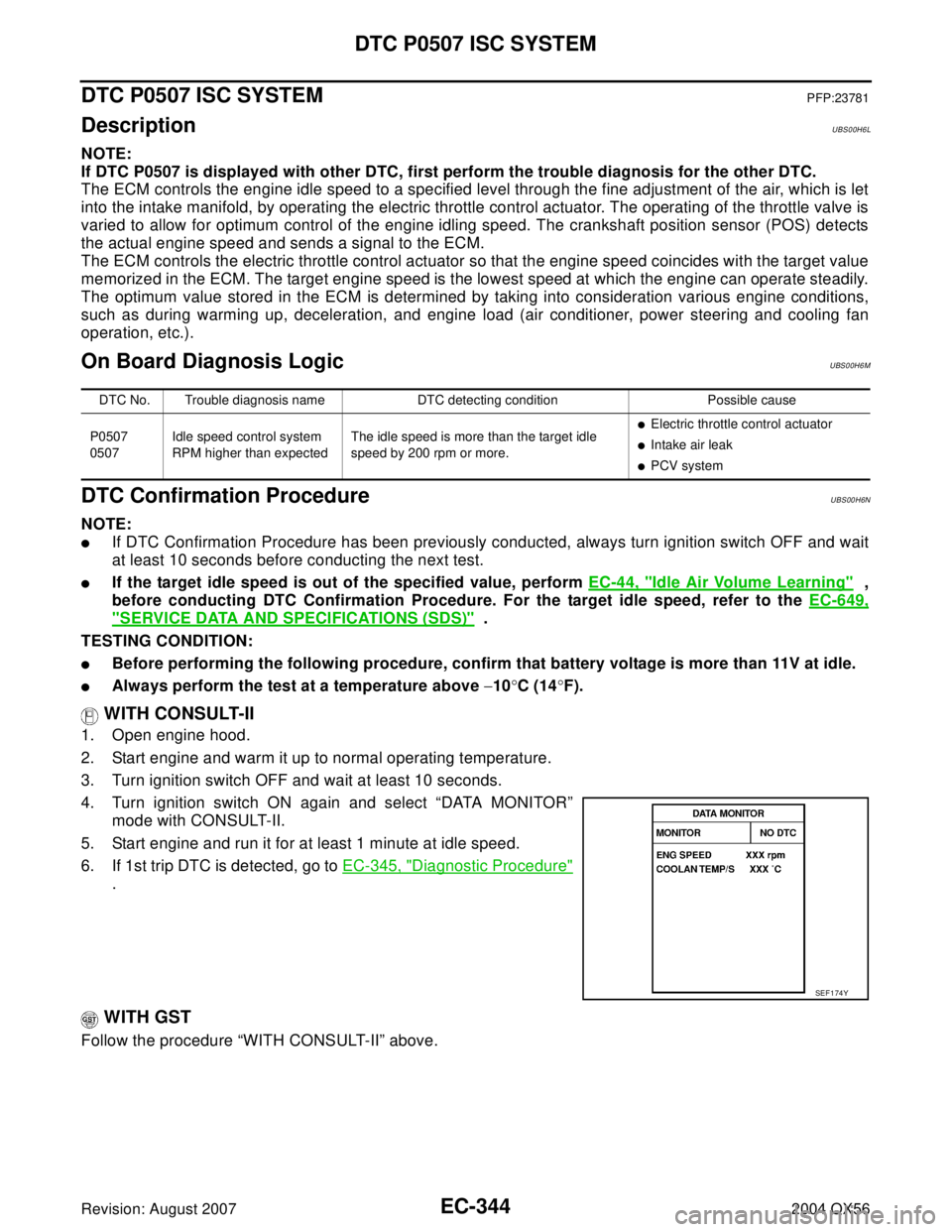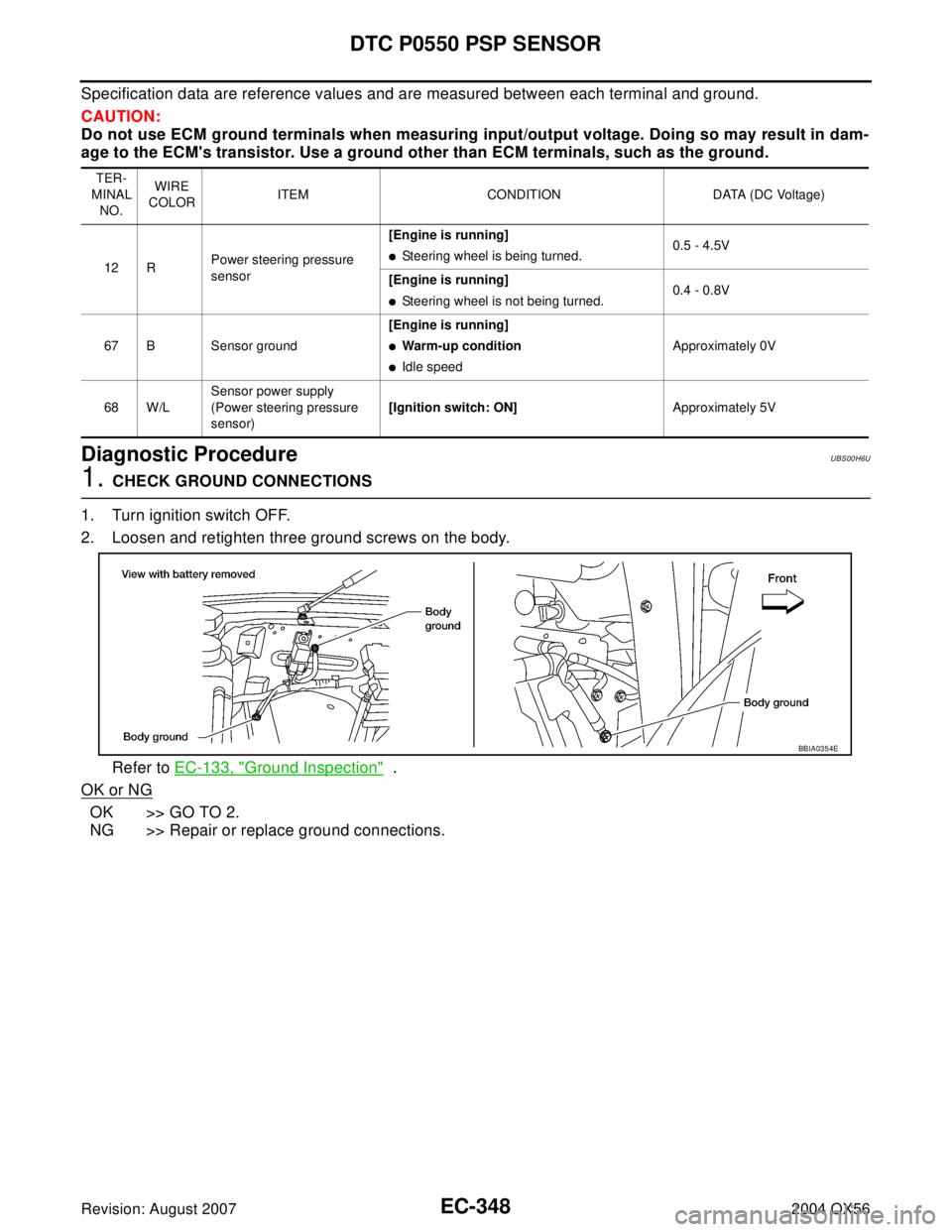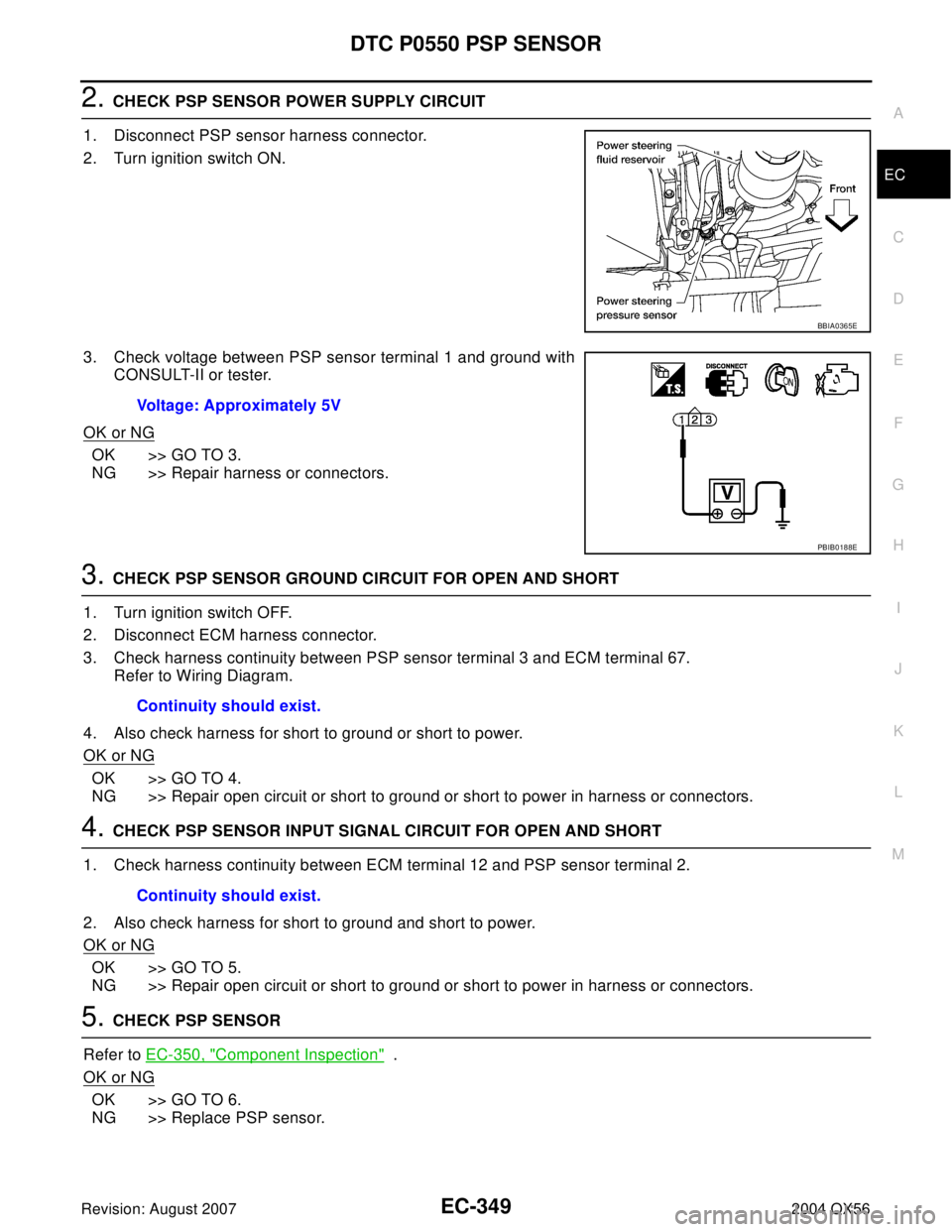Page 1532 of 3371
DTC P0500 VSS
EC-341
C
D
E
F
G
H
I
J
K
L
MA
EC
Revision: August 20072004 QX56
2. Start engine.
3. Read vehicle speed sensor signal in MODE 1 with GST.
The vehicle speed sensor on GST should be able to exceed 10 km/h (6 MPH) when rotating wheels with
suitable gear position.
4. If NG, go to EC-341, "
Diagnostic Procedure" .
Diagnostic ProcedureUBS00H6G
1. CHECK DTC WITH ABS ACTUATOR AND ELECTRIC UNIT (CONTROL UNIT)
Refer to BRC-11, "
TROUBLE DIAGNOSIS" .
OK or NG
OK >> GO TO 2.
NG >> Repair or replace.
2. CHECK DTC WITH COMBINATION METER
Refer to DI-5, "
COMBINATION METERS" .
>>INSPECTION END
Page 1533 of 3371

EC-342Revision: August 2007
DTC P0506 ISC SYSTEM
2004 QX56
DTC P0506 ISC SYSTEMPFP:23781
DescriptionUBS00H6H
NOTE:
If DTC P0506 is displayed with other DTC, first perform the trouble diagnosis for the other DTC.
The ECM controls the engine idle speed to a specified level through the fine adjustment of the air, which is let
into the intake manifold, by operating the electric throttle control actuator. The operating of the throttle valve is
varied to allow for optimum control of the engine idling speed. The crankshaft position sensor (POS) detects
the actual engine speed and sends a signal to the ECM.
The ECM controls the electric throttle control actuator so that the engine speed coincides with the target value
memorized in the ECM. The target engine speed is the lowest speed at which the engine can operate steadily.
The optimum value stored in the ECM is determined by taking into consideration various engine conditions,
such as during warming up, deceleration, and engine load (air conditioner, power steering and cooling fan
operation, etc.).
On Board Diagnosis LogicUBS00H6I
DTC Confirmation ProcedureUBS00H6J
NOTE:
�If DTC Confirmation Procedure has been previously conducted, always turn ignition switch OFF and wait
at least 10 seconds before conducting the next test.
�If the target idle speed is out of the specified value, perform EC-44, "Idle Air Volume Learning" ,
before conducting DTC Confirmation Procedure. For the target idle speed, refer to the EC-649,
"SERVICE DATA AND SPECIFICATIONS (SDS)" .
TESTING CONDITION:
�Before performing the following procedure, confirm that battery voltage is more than 11V at idle.
�Always perform the test at a temperature above −10°C (14°F).
WITH CONSULT-II
1. Open engine hood.
2. Start engine and warm it up to normal operating temperature.
3. Turn ignition switch OFF and wait at least 10 seconds.
4. Turn ignition switch ON again and select “DATA MONITOR”
mode with CONSULT-II.
5. Start engine and run it for at least 1 minute at idle speed.
6. If 1st trip DTC is detected, go to EC-343, "
Diagnostic Procedure"
.
WITH GST
Follow the procedure “WITH CONSULT-II” above.
DTC No. Trouble diagnosis name DTC detecting condition Possible cause
P0506
0506Idle speed control system
RPM lower than expectedThe idle speed is less than the target idle
speed by 100 rpm or more.
�Electric throttle control actuator
�Intake air leak
SEF 1 74 Y
Page 1534 of 3371
DTC P0506 ISC SYSTEM
EC-343
C
D
E
F
G
H
I
J
K
L
MA
EC
Revision: August 20072004 QX56
Diagnostic ProcedureUBS00H6K
1. CHECK INTAKE AIR LEAK
1. Start engine and let it idle.
2. Listen for an intake air leak after the mass air flow sensor.
OK or NG
OK >> GO TO 2.
NG >> Discover air leak location and repair.
2. REPLACE ECM
1. Stop engine.
2. Replace ECM.
3. Perform initialization of IVIS(NATS) system and registration of all IVIS(NATS) ignition key IDs. Refer to
BL-140, "
ECM Re-communicating Function" .
4. Perform EC-44, "
Accelerator Pedal Released Position Learning" .
5. Perform EC-44, "
Throttle Valve Closed Position Learning" .
6. Perform EC-44, "
Idle Air Volume Learning" .
>>INSPECTION END
Page 1535 of 3371

EC-344Revision: August 2007
DTC P0507 ISC SYSTEM
2004 QX56
DTC P0507 ISC SYSTEMPFP:23781
DescriptionUBS00H6L
NOTE:
If DTC P0507 is displayed with other DTC, first perform the trouble diagnosis for the other DTC.
The ECM controls the engine idle speed to a specified level through the fine adjustment of the air, which is let
into the intake manifold, by operating the electric throttle control actuator. The operating of the throttle valve is
varied to allow for optimum control of the engine idling speed. The crankshaft position sensor (POS) detects
the actual engine speed and sends a signal to the ECM.
The ECM controls the electric throttle control actuator so that the engine speed coincides with the target value
memorized in the ECM. The target engine speed is the lowest speed at which the engine can operate steadily.
The optimum value stored in the ECM is determined by taking into consideration various engine conditions,
such as during warming up, deceleration, and engine load (air conditioner, power steering and cooling fan
operation, etc.).
On Board Diagnosis LogicUBS00H6M
DTC Confirmation ProcedureUBS00H6N
NOTE:
�If DTC Confirmation Procedure has been previously conducted, always turn ignition switch OFF and wait
at least 10 seconds before conducting the next test.
�If the target idle speed is out of the specified value, perform EC-44, "Idle Air Volume Learning" ,
before conducting DTC Confirmation Procedure. For the target idle speed, refer to the EC-649,
"SERVICE DATA AND SPECIFICATIONS (SDS)" .
TESTING CONDITION:
�Before performing the following procedure, confirm that battery voltage is more than 11V at idle.
�Always perform the test at a temperature above −10°C (14°F).
WITH CONSULT-II
1. Open engine hood.
2. Start engine and warm it up to normal operating temperature.
3. Turn ignition switch OFF and wait at least 10 seconds.
4. Turn ignition switch ON again and select “DATA MONITOR”
mode with CONSULT-II.
5. Start engine and run it for at least 1 minute at idle speed.
6. If 1st trip DTC is detected, go to EC-345, "
Diagnostic Procedure"
.
WITH GST
Follow the procedure “WITH CONSULT-II” above.
DTC No. Trouble diagnosis name DTC detecting condition Possible cause
P0507
0507Idle speed control system
RPM higher than expectedThe idle speed is more than the target idle
speed by 200 rpm or more.
�Electric throttle control actuator
�Intake air leak
�PCV system
SEF 1 74 Y
Page 1536 of 3371
DTC P0507 ISC SYSTEM
EC-345
C
D
E
F
G
H
I
J
K
L
MA
EC
Revision: August 20072004 QX56
Diagnostic ProcedureUBS00H6O
1. CHECK PCV HOSE CONNECTION
Confirm that PCV hose is connected correctly.
OK or NG
OK >> GO TO 2.
NG >> Repair or replace.
2. CHECK INTAKE AIR LEAK
1. Start engine and let it idle.
2. Listen for an intake air leak after the mass air flow sensor.
OK or NG
OK >> GO TO 3.
NG >> Discover air leak location and repair.
3. REPLACE ECM
1. Stop engine.
2. Replace ECM.
3. Perform initialization of IVIS(NATS) system and registration of all IVIS(NATS) ignition key IDs. Refer to
BL-140, "
ECM Re-communicating Function" .
4. Perform EC-44, "
Accelerator Pedal Released Position Learning" .
5. Perform EC-44, "
Throttle Valve Closed Position Learning" .
6. Perform EC-44, "
Idle Air Volume Learning" .
>>INSPECTION END
Page 1539 of 3371

EC-348Revision: August 2007
DTC P0550 PSP SENSOR
2004 QX56
Specification data are reference values and are measured between each terminal and ground.
CAUTION:
Do not use ECM ground terminals when measuring input/output voltage. Doing so may result in dam-
age to the ECM's transistor. Use a ground other than ECM terminals, such as the ground.
Diagnostic ProcedureUBS00H6U
1. CHECK GROUND CONNECTIONS
1. Turn ignition switch OFF.
2. Loosen and retighten three ground screws on the body.
Refer to EC-133, "
Ground Inspection" .
OK or NG
OK >> GO TO 2.
NG >> Repair or replace ground connections.
TER-
MINAL
NO.WIRE
COLORITEM CONDITION DATA (DC Voltage)
12 RPower steering pressure
sensor[Engine is running]
�Steering wheel is being turned.0.5 - 4.5V
[Engine is running]
�Steering wheel is not being turned.0.4 - 0.8V
67 B Sensor ground[Engine is running]
�Warm-up condition
�Idle speedApproximately 0V
68 W/LSensor power supply
(Power steering pressure
sensor)[Ignition switch: ON]Approximately 5V
BBIA0354E
Page 1540 of 3371

DTC P0550 PSP SENSOR
EC-349
C
D
E
F
G
H
I
J
K
L
MA
EC
Revision: August 20072004 QX56
2. CHECK PSP SENSOR POWER SUPPLY CIRCUIT
1. Disconnect PSP sensor harness connector.
2. Turn ignition switch ON.
3. Check voltage between PSP sensor terminal 1 and ground with
CONSULT-II or tester.
OK or NG
OK >> GO TO 3.
NG >> Repair harness or connectors.
3. CHECK PSP SENSOR GROUND CIRCUIT FOR OPEN AND SHORT
1. Turn ignition switch OFF.
2. Disconnect ECM harness connector.
3. Check harness continuity between PSP sensor terminal 3 and ECM terminal 67.
Refer to Wiring Diagram.
4. Also check harness for short to ground or short to power.
OK or NG
OK >> GO TO 4.
NG >> Repair open circuit or short to ground or short to power in harness or connectors.
4. CHECK PSP SENSOR INPUT SIGNAL CIRCUIT FOR OPEN AND SHORT
1. Check harness continuity between ECM terminal 12 and PSP sensor terminal 2.
2. Also check harness for short to ground and short to power.
OK or NG
OK >> GO TO 5.
NG >> Repair open circuit or short to ground or short to power in harness or connectors.
5. CHECK PSP SENSOR
Refer to EC-350, "
Component Inspection" .
OK or NG
OK >> GO TO 6.
NG >> Replace PSP sensor.
BBIA0365E
Voltage: Approximately 5V
PBIB0188E
Continuity should exist.
Continuity should exist.
Page 1544 of 3371
DTC P0605 ECM
EC-353
C
D
E
F
G
H
I
J
K
L
MA
EC
Revision: August 20072004 QX56
2. REPLACE ECM
1. Replace ECM.
2. Perform initialization of IVIS(NATS) system and registration of all IVIS(NATS) ignition key IDs. Refer to
BL-140, "
ECM Re-communicating Function" .
3. Perform EC-44, "
Accelerator Pedal Released Position Learning" .
4. Perform EC-44, "
Throttle Valve Closed Position Learning" .
5. Perform EC-44, "
Idle Air Volume Learning" .
>>INSPECTION END